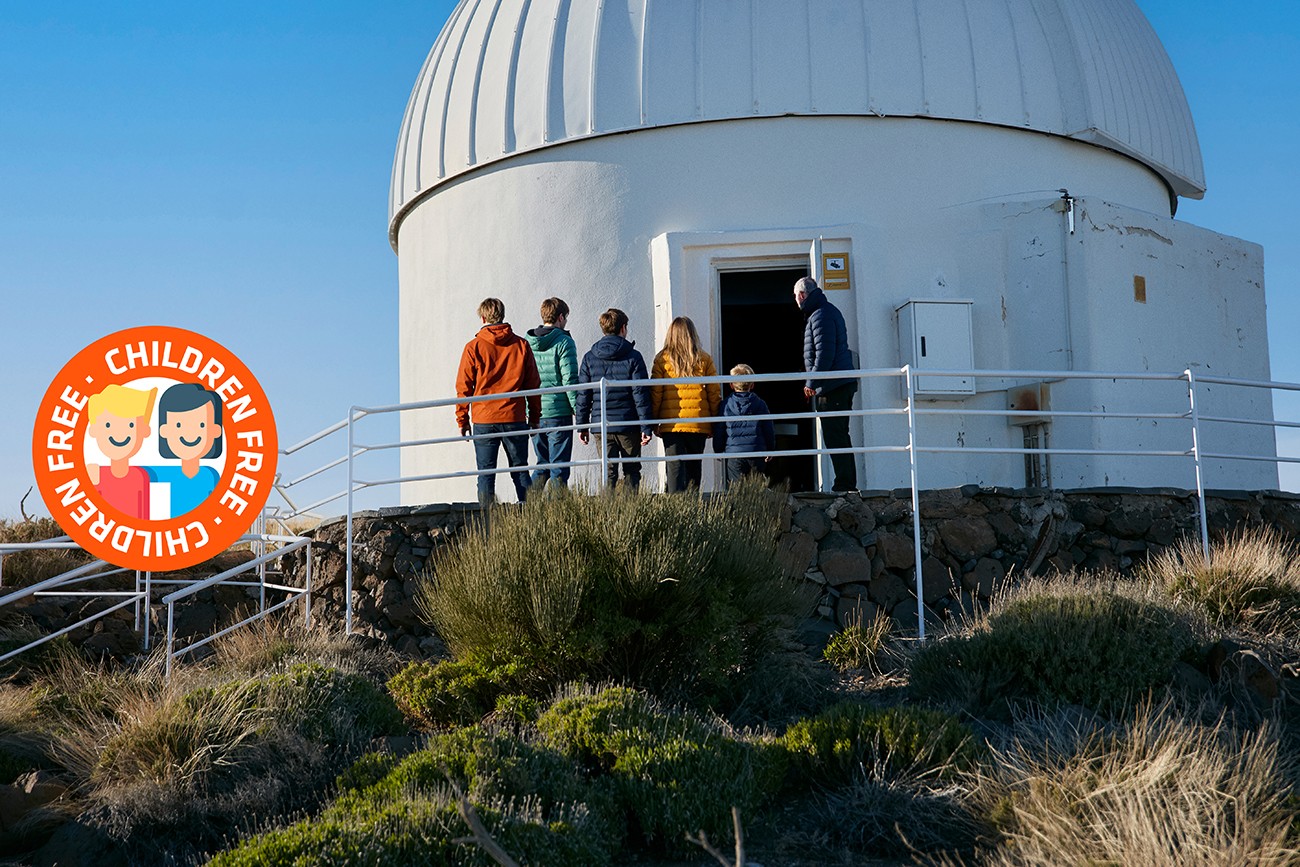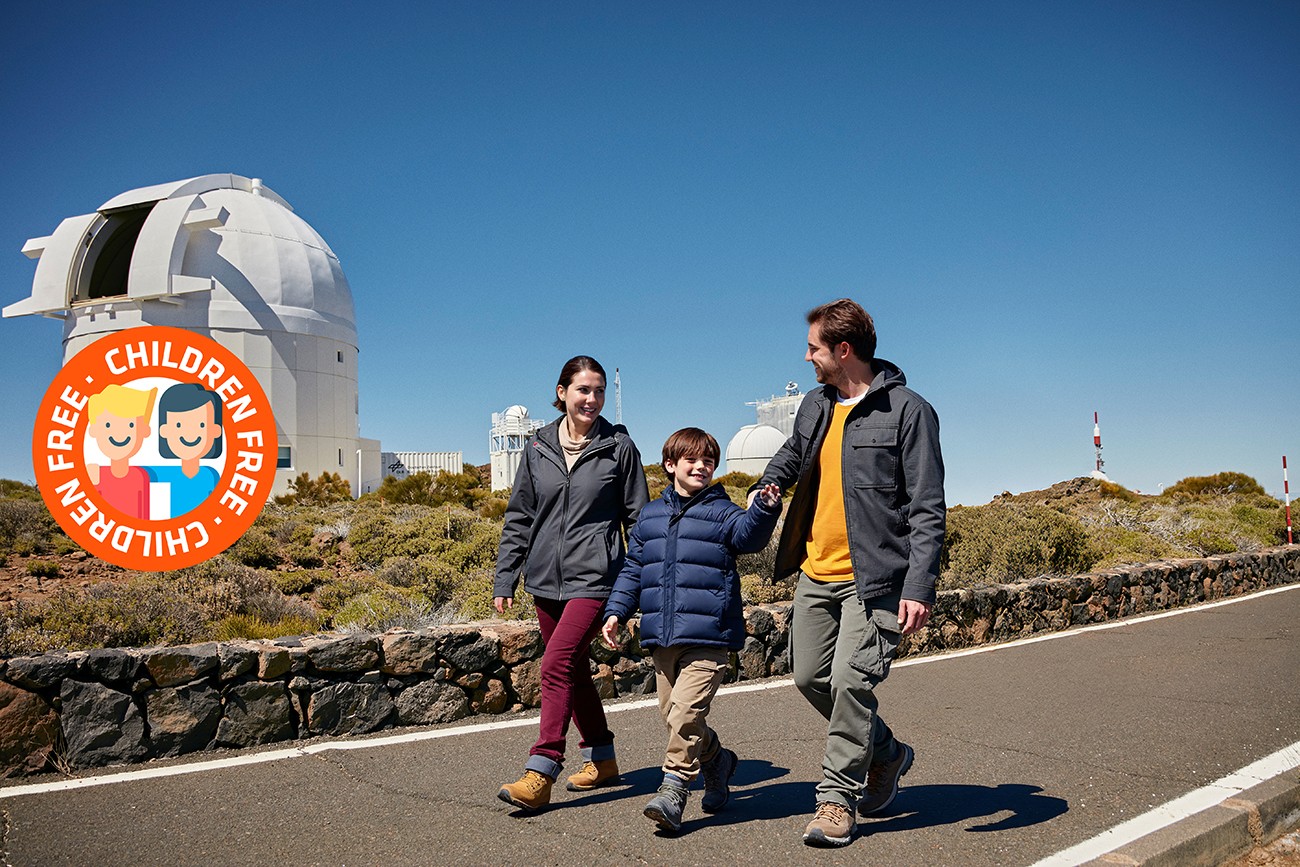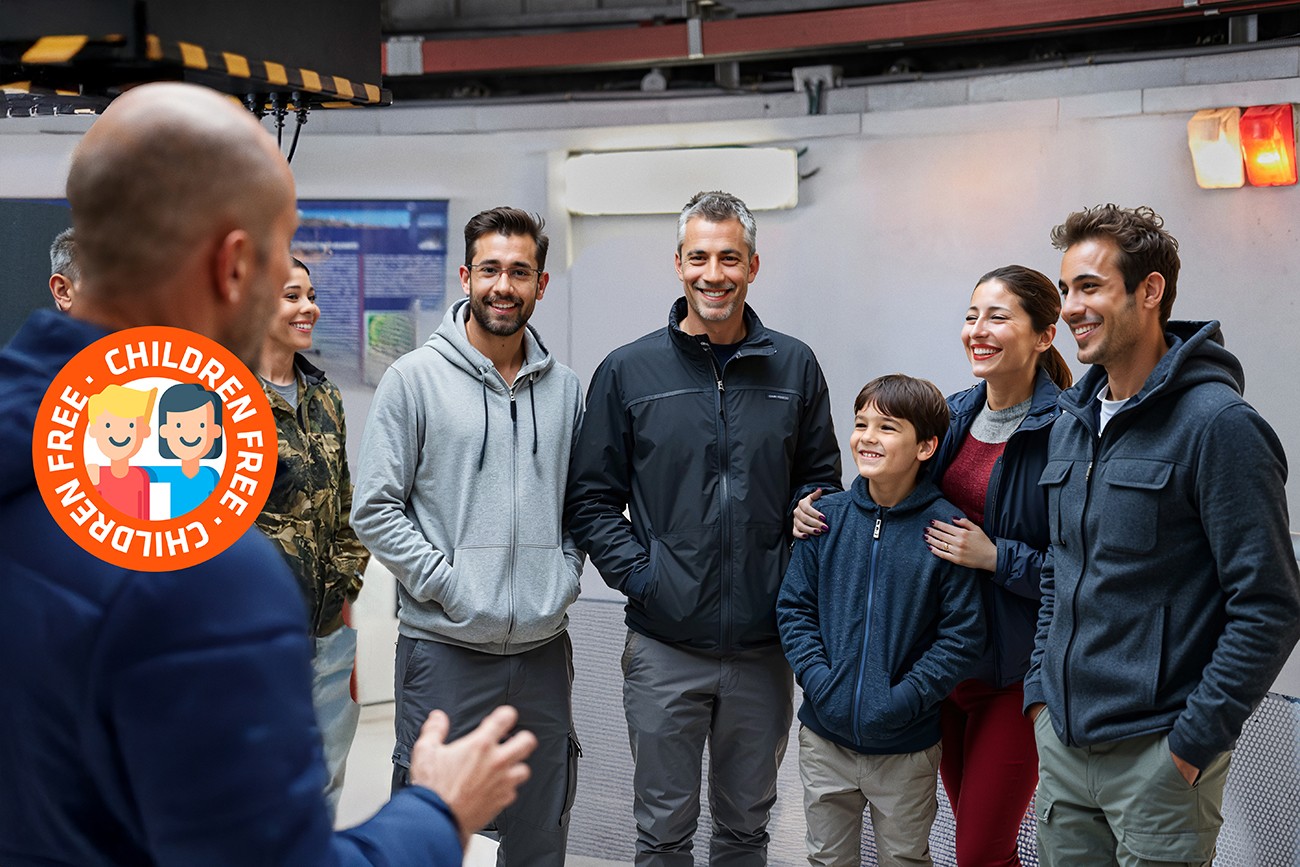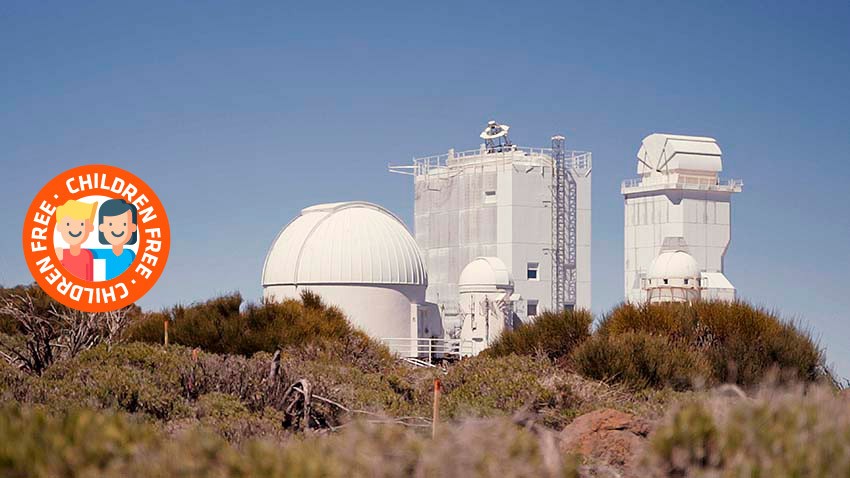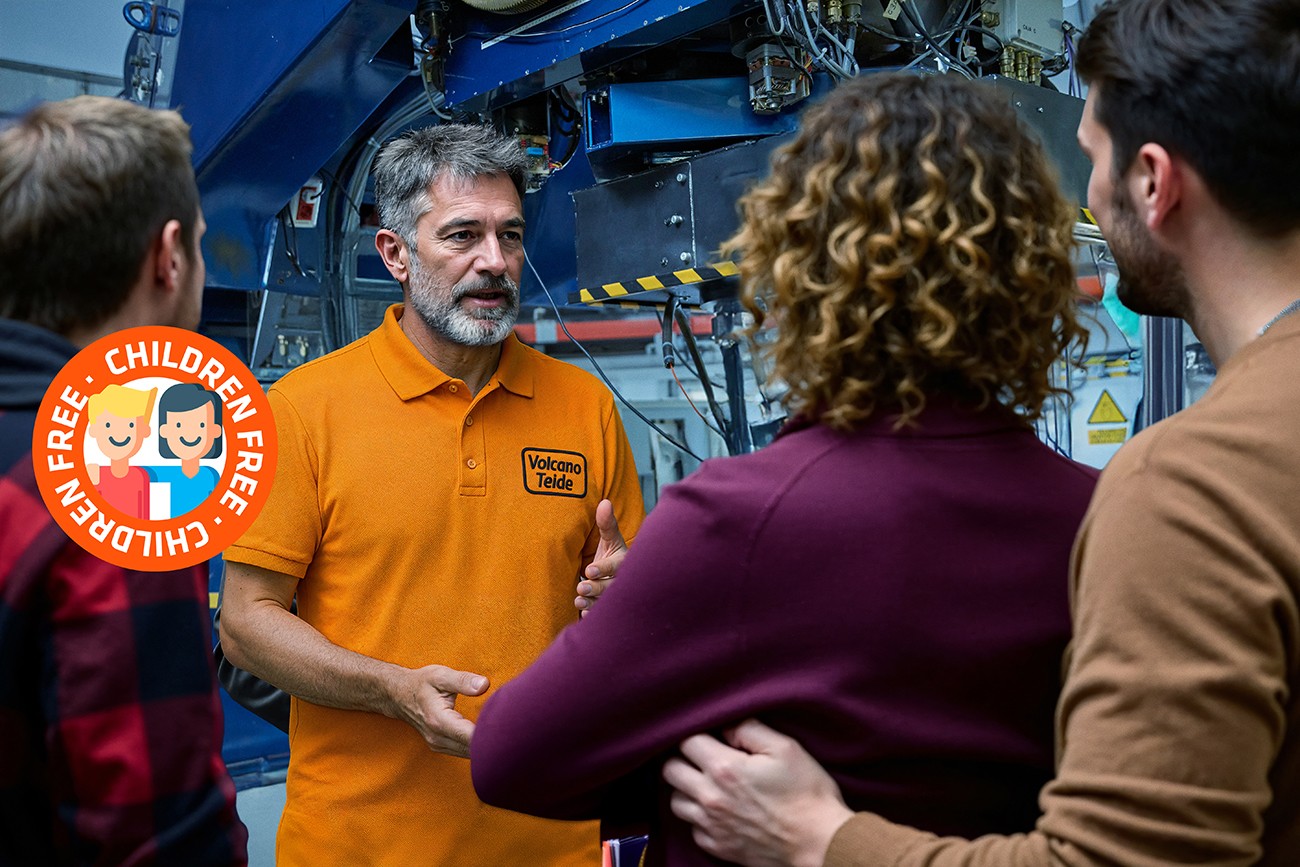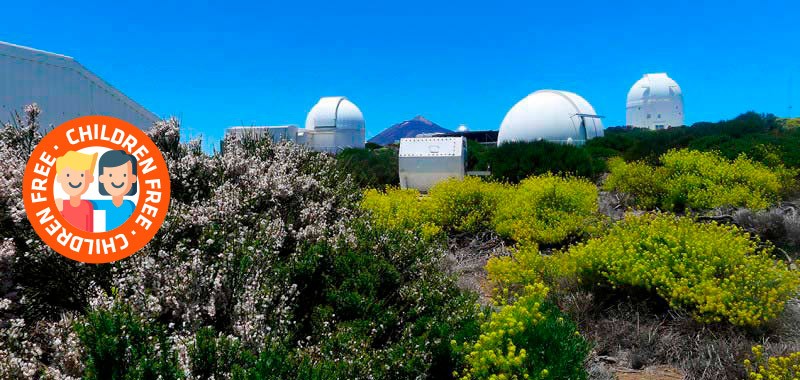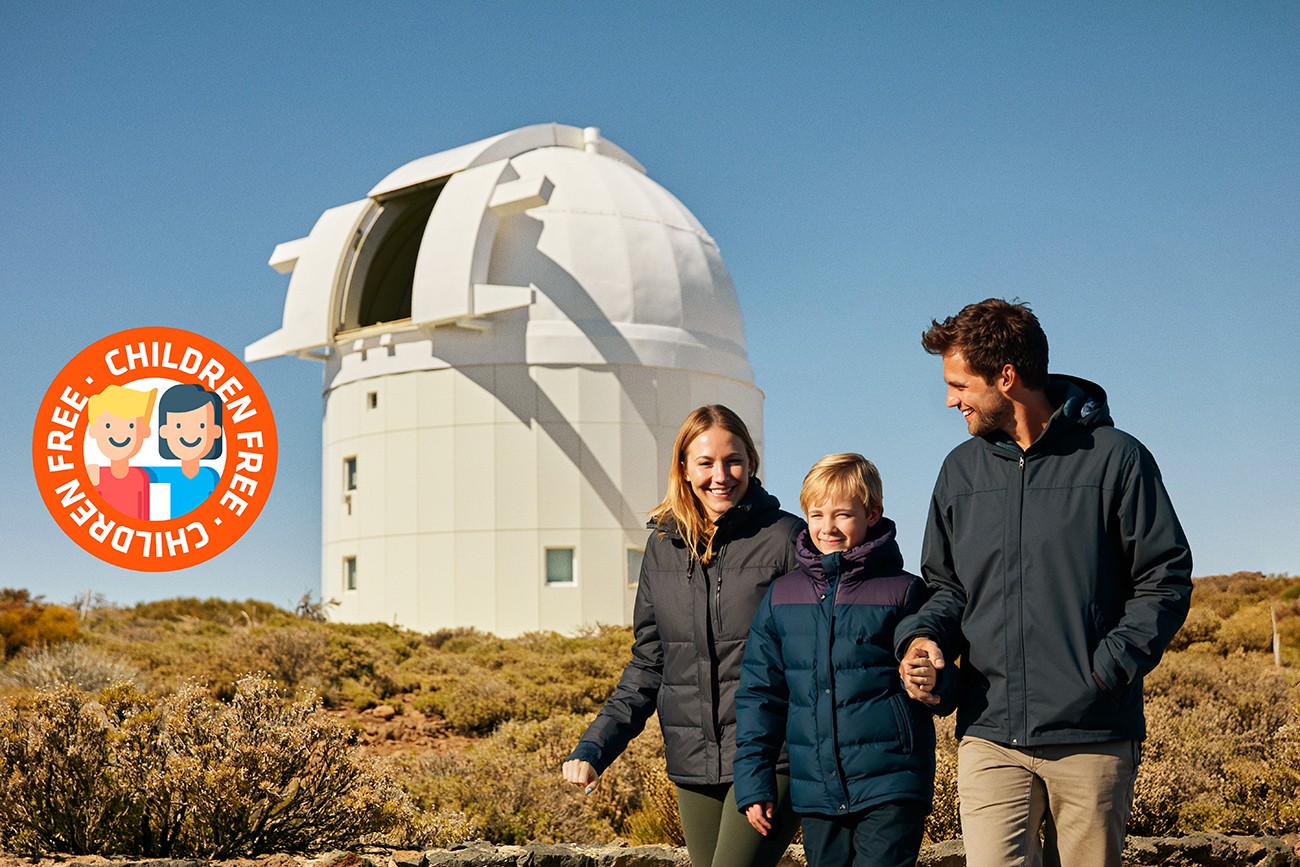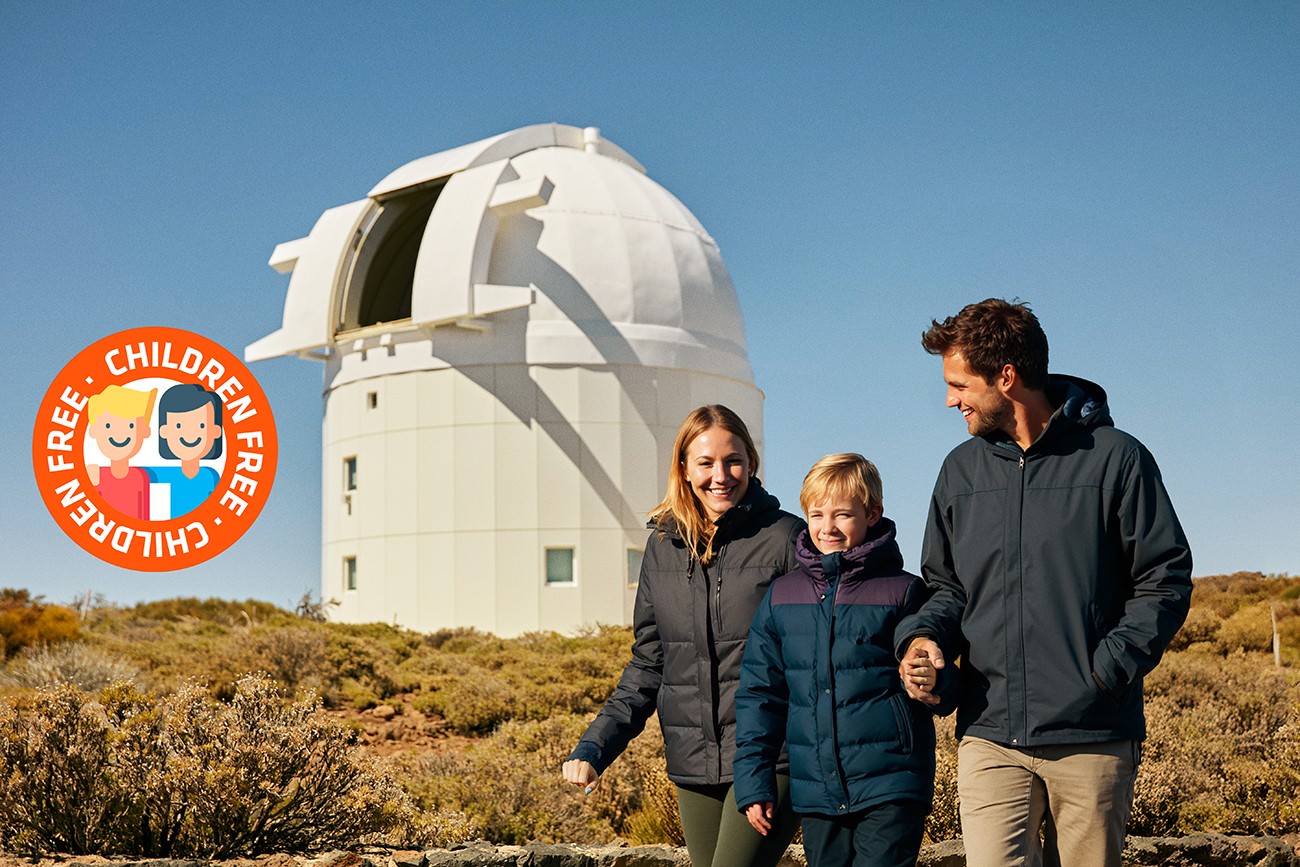- Visit the Teide Observatory during the day
- The largest solar observatory in the world
- You will be amazed by the inside of a nocturnal telescope
- Prepare to be astounded when you observe the Sun
- Guided visit of the Teide Observatory
- Spanish, English, French or German-speaking guide
- Guide in other language than Spanish, English, French or German
- Transportation
Information
Pick-up points and hours
The visits are held from Monday to Sunday in different languages. The time depends on the day booked and is indicated in the booking process. You must arrive at the Izaña Observatory at least 30 minutes before the tour is scheduled to start.
Restrictions
Children under 8 are not allowed to participate in the Teide Observatory guided daytime visit.
The Observatory is not recommended for people with poor general physical health (anaemia, heart disease, respiratory problems, and so on), nor for individuals with reduced mobility as the tour requires the use of paths and stairs.
In order to access the Tenerife Observatory it is necessary to either have own transport or book our transfer service.
If you plan to arrive to the Tenerife Observatory by taxi, please take into account that the driver will have to wait outside its installations until the end of the activity.
It is not allowed to access the premises by bicycle.
Please bear in mind that you must have a sufficient knowledge of the language in which the Teide Observatory guided daytime visit is held in order to be able to correctly follow the explanations of the guide.
Pets are not allowed.
Important information
It is absolutely necessary to produce the booking confirmation, either printed or displayed on a mobile device.
Remember that you must arrive at the gate to the Observatory at least 30 minutes before the scheduled time of the visit. Upon your arrival, you will be instructed by our personnel where to go.
For organisational reasons, the schedule may be modified and notified.
Prepare for your visit
Teide Observatory
Purchase of this service to visit the Teide Observatory implies that you have read and accepted all the points described in the following section:
RECOMMENDATIONS AND WARNINGS FOR VISITORS
We appreciate your interest in visiting theTeide Observatory (OT)and we hope that you enjoy your visit.
The Teide Observatory is not responsible for the difficulties or discomfort caused by not following these recommendations.
The arranged visits will only be carried out when the weather and the operating status of the telescopes permit. Due to adverse weather conditions, especially during winter, which may affect the safety of the roads leading to the Tenerife Observatory (snow, ice, falling rocks) visits may be unexpectedly cancelled.
Before visiting the Teide Observatory
Health and altitude
The Teide Observatory (TO) is located at an altitude of approximately 2,400 meters above sea level, an altitude at which oxygen diminishes. Groups will move about within the Tenerife Observatory on gravel paths. For this reason, the visit is not recommended for people with general health problems (anaemia, breathing or heart problems, etc.). If you are not sure if you should visit, consult your doctor first.
The Teide Observatory is not responsible for any health problems that can be caused by the altitude or by not following these recommendations and warnings.
The Tenerife Observatory does not have medical assistance within its facilities.
Bear in mind that the closest hospital is approximately one and a half hours away by car.
If you show symptoms of dizziness, nausea, shortness of breath, ringing in your ears, plugged ears or headache during your visit, please,immediately inform the guide in charge of the tour of the Teide Observatory.
Recommended equipment for a Teide Observatory guided daytime visit
- Protect yourself from the sun. It’s recommended that you use hats, sunglasses and sunscreen.
- Due to the low levels of humidity that are common in the Tenerife Observatory, bring sufficient liquid (water or juices) to prevent dehydration.
- Bring comfortable clothes and adequate footwear (avoid sandals and heels).
- Bring some warm clothes in case the weather changes abruptly and to enter the interior of the telescopes.
Transportation and punctuality (for visits of the Teide Observatory that do not include pick-up)
We ask that you be very punctual. Bear in mind that the Observatory is located at an altitude of 2,400 m and that you must travel on high mountain roads to reach it. Therefore, please make sure that you calculate well the time needed to reach the Tenerife Observatory.
YOU MUST ARRIVE AT THE TO’s GATE AT LEAST 30 MINUTES BEFORE the scheduled time of the Teide Observatory visit. Upon your arrival, you will be instructed by the personnel attending the visitors to the Teide Observatory where to go.
If you arrive late, the Teide Observatory visit will be cut short (but it will never be extended) by the same amount of time, andcan even be cancelled if the delay is considerable and it causes problems for later scheduled visits.
During your Teide Observatory guided daytime visit
What should I do when I arrive?
When you arrive at the Tenerife Observatory, centre personnel will be waiting for you at the access gate to let you know what to do with the car(s) or couch(es). Please always follow the instructions you receive.
Remember that there is no need to ring the bell, and please do not block the entrance. You may park in the designated parking spaces while you wait.
Please do not forget to bring identification (ID card or passport) and a copy of your reservation to confirm access. If you are unable to produce identification and/or the booking confirmation, the TO/IAC does not guarantee your Teide Observatory visit.
Warnings during the Teide Observatory guided daytime visit
For security reasons, proper operation and care of the environment, the Teide Observatory administration asks you to closely follow the following rules during your Tenerife Observatory visit:
- Since the visits of the Teide Observatory are subject to time limits and schedule constraints, the time to use the toilet is before the visit starts. Please leave the toilet as clean as you found it!
- Please be respectful of the surroundings as the Tenerife Observatory is located in a National Park. It is prohibited to:
- Smoke and eat
- Throw away rubbish except where indicated
- Leave the established paths.
- For your own safety, please remain with your assigned group throughout your Teide Observatory guided daytime visit and follow the instructions given by the guide at all times.
- In case you are given suits or safety equipment in the facilities area, they should be properly used and cared for.
It is absolutely prohibited to leave the safety area or touch anything inside the buildings.
Changes and cancellations
Our facilities
Special rates
Book your Teide Observatory tickets
Visit in French
Visit in German
Visit in Spanish
Visit in English
Where to find us
Location
FAQs
How to get to Teide by car and what to do en route - INTERACTIVE INFOGRAPHIC
What can I do on Mt Teide any day of the week?
How to visit the Teide Observatory in Tenerife
In what languages are guided tours of the Teide Observatory held?
Are night-time visits/observations arranged at the observatory?
What telescopes will I have the opportunity to see during this guided visit of the Teide Observatory?
What telescopes are used for solar observation?
Is it necessary to make a reservation?
Can small children take a guided visit of the Teide Observatory?
Can I take a guided visit of the Teide Observatory if I have mobility problems?
What time do I need to arrive before my guided visit of the Observatory?
Are pets allowed on a guided visit of the Teide Observatory?
Will I have the opportunity to see the inside of a telescope during this guided tour of the Teide Observatory?
What happens if I arrive late at the Teide Observatory and the visit has already started?
Is it necessary to arrive by car for the guided tour of the Teide Observatory?
Can I take photos during my visit of the Teide Observatory?
Do I need to print the booking confirmation of my guided tour of the Teide Observatory?
Reviews of visits to the Tenerife telescope
Visit in French
Visit in German
Visit in Spanish
Visit in English
Description of the visit to the Observatory
Description
Experience the scientific side of Tenerife with a Teide Observatory visit
There’s so much more to Tenerife than the sun and the beach. Inland, almost half of the island lies within the Canary Islands’ Network of Protected Natural Spaces, and a good proportion also belongs to the Natura 2000 Network, which aims to ensure the long-term survival of Europe’s most threatened species and habitats. That may give you a clue as to the environmental importance and richness of Tenerife. The island holds several international awards from UNESCO to attest to its natural and cultural wealth. The Teide National Park has been declared a World Heritage Site, as has the city of San Cristóbal de La Laguna, while the Macizo de Anaga is a World Biosphere Reserve.
The island is volcanoes, sea, sky, forests, historic towns and cities, and more. Its natural treasures and its culture make it a first-class scientific laboratory. Discover it on your visit to the Teide Observatory!
You must already know that the Canary Islands are one of the three best spots in the world to observe the sky, along with Chile and Hawaii, which is why the Tenerife Observatory is the largest solar observatory in the world. The latitude on which the Canary archipelago lies, the altitude of the islands above the sea of cloud and a sky at this height which is always clear, due to the trade winds, explains why we are one of the three most important observatories in the world.
The Teide Observatory came into operation in 1964, a century after the English astronomer Piazzi Smyth visited Tenerife on a scientific expedition in search of the best high-mountain skies for an astronomical observatory. Smyth can be considered a pioneer of modern astronomy, as well as the founder of the Teide Observatory, as he was the first to set up two observatories (one on Mount Teide and another on Mount Guajara) during the course of that 1856 expedition.
The Teide Observatory dedicates its scientific work to solar observation and robotic astronomy. It has a large number of solar and night telescopes belonging to various European countries. What you probably don’t know, yet, is that the researchers who work at the Tenerife Observatory make great contributions to the field of science, with an average of one publication per day.
And did you know that the discovery of the Sun having its own frequency and beating like a heart every five minutes was made at the Tenerife Observatory?
Book your ticket today, to visit the Teide Observatory with us, to discover this spectacular scientific centre during the day, and to get to know the Tenerife Observatory and the activities of the researchers who work there, in an enjoyable way.
Our guides will make you feel like a scientist for a day as during this Tenerife Observatory visit:
- You will be introduced to the importance of the sky in the Canary Islands, the Teide Observatory telescopes and the different projects of the Canary Islands Institute of Astrophysics, the institution that manages this solar observatory.
- You will participate in a workshop on astrophysics given at the visitors’ centre, in which our guides will explain what astrophysics is and how astrophysicists work.
- You will observe sunspots and solar flares through two solar telescopes, which you will have at your disposal to fully enjoy them.
- You will explore the inside of a nocturnal telescope and won’t leave until you know how it functions and learn about its exciting history.
You can also visit the Tenerife Observatory with other activities which include a tour of the Teide Observatory.

